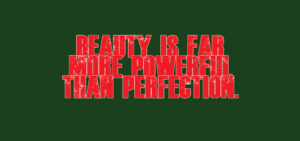We prefer beauty to perfection.
If in doubt, look to art.
Not to be more arty.
But by understanding how images and words combine to engage people.
To engage customers.
People prefer beauty to perfection.
Islamic artists will often leave a deliberate mistake in their art.
The reason shows humility and wisdom. They will tell you, “Only God is perfect.” And, by allowing the artist the freedom of a mistake, the artist can create a pattern where the artistic outcome complements and surpasses the limitations decreed by pure geometry.
Punjabi weavers will create a deliberate break in the pattern of their blankets.
Navajo weavers, similarly, will include imperfections. Delightfully, they believe each blanket contains a piece of the artist’s soul. As such, they will often include a spirit line, stitched from the main pattern to the edge of the blanket, so this piece of their soul can escape and not be trapped forever in the blanket.
(As a writer, I can only empathise.)
I particularly love the idea behind the Japanese art of Wabi Sabi.
Taking imperfections and making them a focal point of the design. Fixing a shattered bowl with gold to create an even more beautiful, if less symmetrically perfect, design. (Something echoed in the late, great Paul Arden’s axiom. To create a great ad, take the weakest part and make it the strongest design element.)
They balance the imperfection with beauty.
Or Marcel Duchamps’ The bride stripped bare by her bachelors, even. A work on glass, he wanted to leave deliberately unfinished – his words reflecting da Vinci’s obsessive lifelong tweaking of the Mona Lisa. The work was shipped to New York and broken on the way. Shattered. Everyone was, understandably, mortified. Except Duchamps, who looked at the piece and declared the shattered pattern actually added to the art. Finishing it in a way he could never have managed himself.
One relevant truth behind all of these is the invisibility of perfection.
If every aspect of a piece is perfect, there is nothing to catch the eye of the beholder. Our brains are wired to seek the tiny things which should not be there – it saved us from being eaten by tigers back in the day.
By celebrating the imperfection, we create pieces which are more noticeable, and more engaging.
Which, at the end of the day, is what we, as communicators, desire most.
The trouble is, most marketers look for the imperfections and strip them away. (It is, after all, easier to see what’s wrong with a work than what’s right with it. And we do love having our opinions heard.) We then insist on replacing the offending imperfection with either an inoffensive addition, or a perfectly sound piece of logic. Both of which not only decrease the attraction of the piece but also its capacity to engage.
If we make a piece too smooth, the viewer’s attention will slide right off it.
Which is exactly the opposite of what the client is paying us for.
Be humble.
Don’t aim for perfection.
Aim for beauty.



Leave A Comment